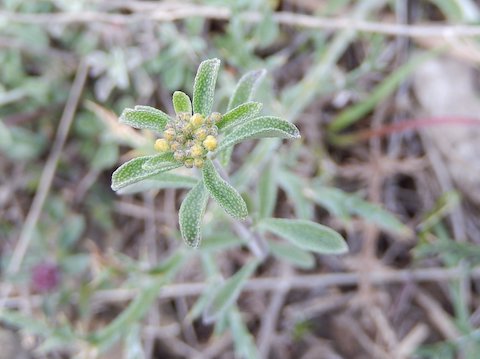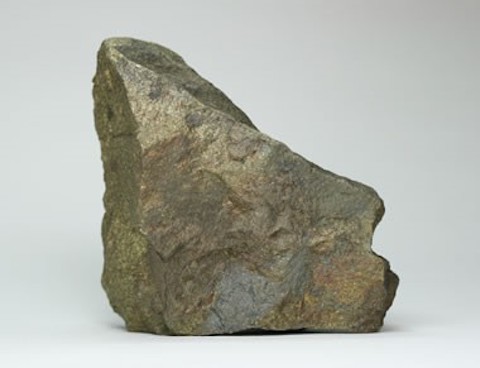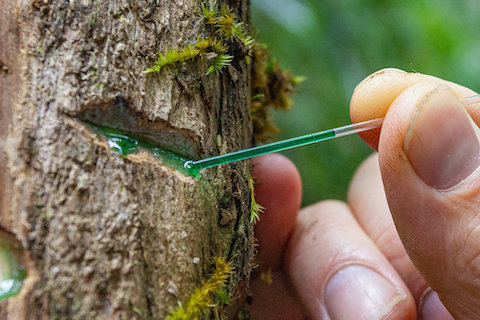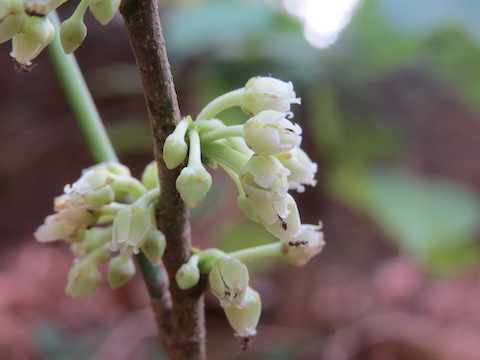Nickel is in demand because it’s used in lithium ion batteries, common alloys such as stainless steel, and new super alloys for the aerospace and wind turbine industry.
But mining and smelting nickel is energy intensive, using a great deal of diesel fuel and coal. And the after-products are environmentally dangerous.
Luckily, we’ve found that nickel can grow on trees. Or more specifically, shrubs.
Metals are toxic to most plants, which don’t grow in metal-rich soils. But some 700 species are hyperaccumulators—they actually pull metal from the ground and concentrate it in their tissues.
It’s thought they do this to ward off pests or to help absorb potassium from poor soil.
Of these species, over 400 accumulate nickel. Their blue-green sap can be up to 25% nickel—a concentration twenty times greater than the nickel ore mined for smelting.

These shrubs can be farmed and the metal harvested in a technique called phytomining.
Farmers cut back the shrubs once or twice a year and either squeeze sap from the foliage or burn it and gather the ash.
The farms can be sited on nickel-rich soils that have been corrupted with mine tailings or are otherwise unfit for agriculture.
After a couple decades, the plants will deplete the nickel in the soil through a process called bioremediation, and the land can grow food crops.
Nickel farming will never replace large-scale mining, but it can help small farmers earn a living in areas with toxic soils.
Background
Synopsis: We love nickel because it makes modern life possible in many ways, such as by strengthening alloys like stainless steel and serving as cathodes in smartphone and electric car batteries. But mining and refining nickel is energy intensive and leaves behind toxic wastelands.
- Some plants love nickel, too—it is one of the most common metals collected by plants known as hyperaccumulators. Growing these plants in high-nickel soils related to mine tailings or low-grade ore deposits can concentrate the nickel for easy extraction and remediate the metallic soil in a couple decades, allowing the soil to be used for other crops.
- Nickel is a silvery white metal that is a key ingredient in the production of stainless steel, battery cathodes, catalysts, and even coins. It provides important corrosion resistance for alloys and enables metals to withstand extreme temperatures, which is especially important for harsh-environment applications.
- Most of the nickel mined today is used to make stainless steel and super alloys required for turbines by the aerospace and electric power generation industries.
- Nickel is the most prevalent metal by weight in today’s lithium-ion battery cathodes and is expected to become even more important in batteries of the future.
- A small percentage of nickel is used in coins. The modern U.S. five-cent coin is only 25% nickel—the remaining 75% is copper. All U.S. coins actually contain some nickel.
- If your glasses rims flex and bounce back after bending, they are made of a nickel-titanium alloy designed to have shape memory.
- Nickel is commonly used for metal plating—you may have nickel-plated faucets or doorknobs at home.
- Nickel is also found in chemical catalysts.
- Nickel is the fifth most common element on Earth, but most of it is concentrated in the inner and outer core. Earth’s crust is only about 100 parts per million nickel, but the liquid outer core and solid inner core are thought to be about 20% nickel and 80% iron.
- Nickel likes to associate with both iron and sulfur. Iron, magnesium, and nickel ions are similar in size, so they easily substitute for each other.
- Nickel was discovered in 1751 and originally thought to be a stubborn type of copper ore that was difficult for miners to extract using the means available at the time. It was called Kupfernickel—German for “copper” (Kupfer) and “demon” or “goblin” (Nickel).
- Global reserves of nickel are stable and spread across more than 10 countries.
- Eagle Mine, in the Upper Peninsula of Michigan, is the only producing nickel mine in the United States. It began production in 2014 and will produce ore for just 8 years. It also produces copper and small amounts of precious metals.
- Nickel mining accesses two main types of nickel deposits: sulfides and laterites.
- Magmatic nickel sulfides—like those in Canada, Australia, and Russia—represent about 40% of global reserves but about 50% of annual global nickel production.
- They form in basal sulfide-rich layers in volcanic and plutonic magma chambers and consist principally of pentlandite (nickel-iron sulfide) along with pyrrhotite (iron sulfide).
- The second largest nickel deposit in the world is the Sudbury Igneous Complex in Canada, which formed from an asteroid impact 1.85 billion years ago that melted Earth’s crust, producing a magma chamber that accumulated metal sulfides along its base as it cooled.
- Lateritic soil deposits, which occur in Indonesia, the Philippines, Cuba, and New Caledonia, contain the remainder of Earth’s recoverable nickel resources.
- These rocks form in warm, humid conditions typical of tropical settings. They are the weathering products of ultramafic deposits, or deposits of igneous rocks with very low silica content such as peridotite, olivine, and serpentinite.
- They are composed of limonite (iron-nickel oxide-hydroxide) and garnierite (hydrous nickel silicate).
- The ocean floor contains manganese crusts and nodules that are concretions of iron-manganese oxides also containing nickel, but it is not mined at present.
- Chondrite meteorites have 100–1000 times as much nickel as most rocks on Earth’s surface.
- Magmatic nickel sulfides—like those in Canada, Australia, and Russia—represent about 40% of global reserves but about 50% of annual global nickel production.

- Mining and refining of nickel and other metals are very energy intensive processes that typically rely on power from coal or diesel fuel. Abandoned mines also leach metals and acidic effluent into water supplies, creating huge remediation problems for mining companies.
- Fortunately, nickel is very effectively recycled, with more than 40% of the annual U.S. supply coming from recycling efforts.
- The increasing need for metals to produce consumer electronics has recently driven us to consider technological feats like mining the ocean floor or sources in outer space. But is there a simpler solution? Could we grow metal crops on farms?
- In a previous EarthDate episode, we learned about eucalyptus trees that concentrate trace amounts of gold in their leaves, providing miners with a less invasive way to locate deeper ore bodies.
- Farming for metals is called phytomining, and metal crops are known as bio-ores.
- Although the idea of metal farming was first proposed by Georgius Agricola more than 500 years ago, patents have limited the application of this technology for decades. But now those patents have expired.
- Farmers can produce a crop of metal via phytomining by growing specific plants that thrive in soil with metal concentrations that would be toxic to most plants.
- There are more than 700 species of plants that hyperaccumulate metals. Some hoard metals at levels thousands of times higher than those of their average cousins.
- Nickel is one of the most common metals concentrated by plants. Zinc, cobalt, and other metals are also hyperaccumulated by certain species.


- Nickel is toxic to most plants and will kill most vegetation, but plants known as nickel hyperaccumulators thrive in nickel-rich soil and ooze blue-green nickel-concentrated sap.
- At up to 25% nickel, the sap is far more concentrated than rock-based nickel ores typically used at smelters, which might have nickel concentrations as low as 1.2%.
- Thus far, researchers have documented about 450 nickel hyperaccumulators on Earth, many of which have evolved in areas with nickel-rich lateritic soils like the Philippines and Indonesia.
- These plants hoard nickel, concentrating it up to 18,000 ppm. It is thought that the nickel helps the plants repel pests and possibly also uptake potassium from the notoriously poor-quality soil of these areas.
- Nickel-rich soils occur where low-grade lateritic ore bodies reach the surface and where mine tailings, or waste materials, are left behind.
- Soil with concentrations of around 0.1% nickel can be remediated using nickel hyperaccumulators, and the metals can be mined from the plant biomass.
- Local farmers can harvest about 1 ft of growth from their plots every 6–12 months. They can squeeze out the nickel-concentrated sap or burn the plant, purifying it into nickel citrate. A typical harvest of 500 lb (227 kg) can be sold for thousands of dollars.
- After a couple of decades, the nickel in the soil will become depleted, but once that happens the soil is remediated and could even be used for food crops.
- Nickel farming will never replace traditional mining, but it can help small farmers in areas with toxic soils to make their land productive for the metal.

